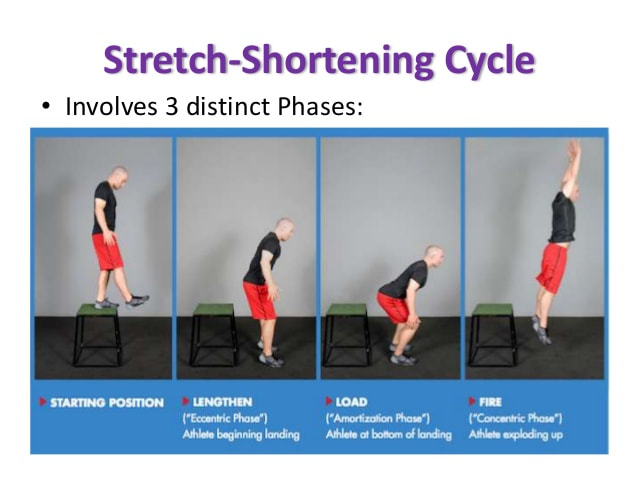|
ADAPTATIONS - LOCAL MUSCULAR ENDURANCE/WORK CAPACITY: target a specific muscle group by holding one position for an extended duration - ACIDOSIS TOLERANCE: performing an isometric in the bottom portion of a movement when the muscle is stretched, causes occlusion leading to a large build of metabolites - LACTATE UTILIZATION: when these metabolites are built up and trapped in the muscle, it improve your ability to recycle them and use them as an immediate fuel source, since there is minimal new blood flow into the muscle - TENDON HEALTH: increased tendon and connective tissue thickness and load tolerance - INCORRECT COMPENSATION PATTERNS: simplifies teaching individuals how to drive through/fire the correct muscle groups to perform the movement maximally and efficiently - MECHANICAL STRESS ON JOINTS: due to the minimal amount of movement and impact that takes place the joints experience nearly no negative effects HOW TO · COACHING CUE: when performing isometric don’t think about resisting going down agonist muscles, think about pulling self-down with antagonist muscles (IE: in Bench Press think squeezing scaps down and back to get bigger stretch in chest) · Perform the isometrics for 3-5 MINUTES at a near maximal intensity · Hold the isometric in the disadvantageous/bottom position of the movement where the muscle is stretched · Choose exercises that mimic/utilize muscle groups that are important to high performance in your sport IMPLEMENTATION DURING GPP (Block 2: Option B) · PRESCRIPTION · 1 set each exercise: 3-5 minutes work/ 3-5 minutes rest, 1-2x per week · Start with 15-25% of max for load · EXERCISES · Right Split Squat, DB Bench Press, DB Chest Supported Row, Left Split Squat, DB Z Press, Glute Bridge w/ Plate Pullover
1 Comment
HOW TO · LACTATE RETENTION METHOD is completed by performing an isometric movement immediately following an exercise interval that produces lactate/metabolites · The ISOMETRIC MOVEMENT that is used must utilize the same muscle groups as the previous exercise interval and be held at a long muscle length for 20-40 seconds · The EXERCISE INTERVAL must produce lactate/metabolites (generally meaning it must occur 20-40 seconds at minimum and be performed at a high intensity) ADAPTATIONS · Improved LOCAL MUSCULAR ENDURANCE/acidosis tolerance · Increased ability to SUSTAIN HIGH POWER OUTPUTS for longer/lactate tolerance · Enhanced LACTATE UTILIZATION · Increased time under tension/HYPERTROPHY OTHER BENEFITS · Experience LESS MECHANICAL DAMAGE on joints when performing isometrics for extra volume instead performing more repetitions · Train at HIGHER INTENSITIES during volume phases because a large percentage of work is made up by submaximal isometric movements · Improve BODY AWARENESS by correcting positions and ensuring the right muscles are firing during isometric · MINIMIZE fatigue and soreness during high volume training IMPLEMENTING LRM · It can be done with any form of exercise that produces lactate · For conditioning purposes, I prefer to use bike sprints, stair sprints, jumps squats, and jumping lunge · For hypertrophy purposes, I use compound movement like squats, split squats, presses, and pulls · When using LRM the adaptations are not global and are only applicable to the muscle group being utilized, so choose the exercises based on the needs of the individual you are working with Click Link Below to Lactate Retention Method Article LACTATE RETENTION METHOD - MUSCLE ACTIVATION: highest level of motor unit recruitment - INTRAMUSCULAR COORDINATION: turning the right muscles on/off for efficient movement - VASCULAR SYSTEM ELASTICITY: decrease RHR, limit metaborerlex & remove blockages - FAST TWITCH FIBER CAPACITY: increase mitochondrial density and oxygen utilization capabilities HOW I IMPLEMENT THEM IN GPP (Block 2: Option A) - PRESCRIPTION - 3-5 sets: 5-10 sec work/ 30-60 sec rest, 1-2x per week (circuit fashion) - EXERCISES - Split Squat Deadlift, Bench Press, SL Hip Thrust, Chest Supported Row, Mid-Thigh Pull, Z-Press
- STRENGTHEN WEAK POINT OF MOVEMENT: perform the isometric at/near your sticking point to strengthen that part of the movement - ELIMINATE “LAZY” ISOMETRICS: prevents athletes from relaxing and not maintaining tension at the bottom portion of a movement (bar resting on chest during bench press, sitting on heels in squat) - SELF REGULATES TRAINING INTENSITY: perfect for high volume training because you cannot train at high intensities due to the majority of the volume occurring at the weak points of the movement - INCREASE TIME UNDER TENSION: accumulate large amounts of volume with minimal mechanical damage, due to very few total reps being performed over the course of a set - DIFFERENTIATE ECCENTRIC & CONCENTRIC PORTION OF LIFT: develop an understanding/awareness of which muscles should be lengthening/shortening during each portion of lift · SIMPLE way to make light weights feel heavy · STRENGTHEN weakest point of movement · SELF-REGULATES exercise intensity (percentage) · Allow for smooth TRANSITION to heavier loads during eccentric · Minimizes using the “bounce” out of the bottom portion High volume upper body workout today with an isometric emphasis 1A. BB Incline BP: 3x4+4 (3s + 3s iso) 1B. Iso Push Up: 3x25s+25s 2A. Z Press: 3x4 (3s + 3s iso) 2B. DB JM Press: 3x8 (3s iso) 2C. Chin Up: 3x8 (3s iso) 2D. Landmine Press: 3x8 (3s iso) 2E. SA DB OH Tri Ext.: 3x8 (3s iso) 2F. DB Chest Supported Row: 3x8 (3s iso) |
Categories
All
Archives
February 2023
Regan QuaalHead Strength & Conditioning Coach at Shakopee High School |
||||||||||||||||||||||||||||||


 RSS Feed
RSS Feed